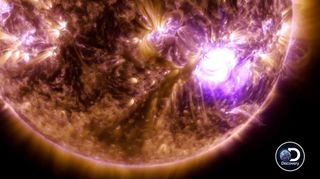'Dark Side of the Sun' Doc Examines the Devastating Threat of Solar Storms

A new documentary narrated by music legend Sting examines the extreme threat that solar weather poses to modern society.
The hour-long TV doc, titled "The Dark Side of the Sun," leads with the story of the 1859 "Carrington event," when the sun spit a mass of charged particles straight at the Earth. This sent a surge of current through telegraph wires ("the Victorian internet" according to one scientist in the documentary) and created auroras as far south as Cuba. If a similar event hit Earth today, the surge of electricity could potentially shut down power grids for weeks or even months, and severely damage satellites. This would have a major impact on communications, GPS and internet connections, according to the scientist interviewed for the film.
The documentary certainly seems to suggest that people should be afraid of what these solar events could do to Earth. But thankfully, the broadcast also shows viewers the steps being taken to prepare for such an event, including new space missions to study the sun and improve solar weather forecasting. [The Sun's Wrath: Worst Solar Storms in History]
One of the science missions featured in "The Dark Side of the Sun" is the National Science Foundation's Daniel K. Inouye Solar Telescope (DKIST), currently under construction on the island of Maui in Hawaii, and scheduled to begin operations in 2019. DKIST will be "the largest solar telescope in history," said a statement from Discovery. The instrument is located on a mountaintop called Haleakalā, which means, appropriately, "house of the sun."
The second science mission is NASA's Solar Probe Plus, which is set to launch into orbit around the sun in 2018. That satellite mission will include seven flybys of Venus, and a daring dive through the sun's corona (or atmosphere). That mission will contribute to NASA's already-existing fleet of solar-observing satellites.
"The Dark Side of the Sun" provides a concise and fascinating look at the basic science behind solar weather and the threat it poses to humans. The scientists featured in the doc add personality to the story, and drive home just how hypnotizing Earth's parent star is, despite its dangers. Both DKIST and Solar Probe Plus will give humans the tools to help prevent a major catastrophe caused by a solar weather event. These instruments will also help scientists answer fundamental questions about the sun, including the truly perplexing mystery of why the star's corona is so much hotter than its surface.
Get the Space.com Newsletter
Breaking space news, the latest updates on rocket launches, skywatching events and more!
"The Dark Side of the Sun" will air on Discovery Channel this Saturday (Feb. 11), and again on Science Channel on Sunday (Feb. 12).
Follow Calla Cofield @callacofield.Follow us @Spacedotcom, Facebook and Google+. Original article on Space.com.
Join our Space Forums to keep talking space on the latest missions, night sky and more! And if you have a news tip, correction or comment, let us know at: community@space.com.

Calla Cofield joined Space.com's crew in October 2014. She enjoys writing about black holes, exploding stars, ripples in space-time, science in comic books, and all the mysteries of the cosmos. Prior to joining Space.com Calla worked as a freelance writer, with her work appearing in APS News, Symmetry magazine, Scientific American, Nature News, Physics World, and others. From 2010 to 2014 she was a producer for The Physics Central Podcast. Previously, Calla worked at the American Museum of Natural History in New York City (hands down the best office building ever) and SLAC National Accelerator Laboratory in California. Calla studied physics at the University of Massachusetts, Amherst and is originally from Sandy, Utah. In 2018, Calla left Space.com to join NASA's Jet Propulsion Laboratory media team where she oversees astronomy, physics, exoplanets and the Cold Atom Lab mission. She has been underground at three of the largest particle accelerators in the world and would really like to know what the heck dark matter is. Contact Calla via: E-Mail – Twitter
